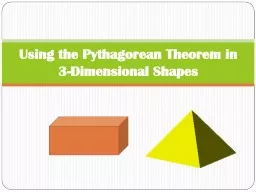PPT-Using the Pythagorean Theorem in 3-Dimensional Shapes
Author : sherrill-nordquist | Published Date : 2018-11-12
Pythagorean Theorem Review The Pythagorean Theorem states in any right triangle the square of the hypotenuse is equal to the sum of the squares of the other two
Presentation Embed Code
Download Presentation
Download Presentation The PPT/PDF document "Using the Pythagorean Theorem in 3-Dimen..." is the property of its rightful owner. Permission is granted to download and print the materials on this website for personal, non-commercial use only, and to display it on your personal computer provided you do not modify the materials and that you retain all copyright notices contained in the materials. By downloading content from our website, you accept the terms of this agreement.
Using the Pythagorean Theorem in 3-Dimensional Shapes: Transcript
Download Rules Of Document
"Using the Pythagorean Theorem in 3-Dimensional Shapes"The content belongs to its owner. You may download and print it for personal use, without modification, and keep all copyright notices. By downloading, you agree to these terms.
Related Documents














